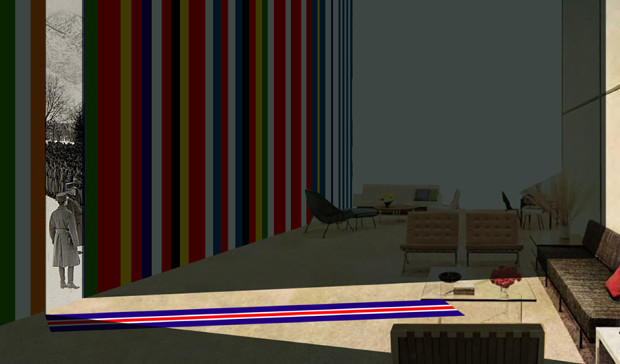
Rem Koolhaas's EU lounge for the Design Museum
Discover why the lovely furniture, and scary crowd, suit the museum’s forthcoming exhibition Fear and Love
What kind of desires make us favour a Dieter Rams chair over an Ikea one? What kind of allegiances might make us favour a British or American airline over, say, a Chinese or German carrier? What misgivings compel us to buy a burglar alarm, a bicycle helmet, a Volvo car or a Glock pistol?
The opening exhibition at London’s new Design Museum tries to get behind the formal, aesthetic and functional aspects of design, to examine how it is deeply connected not just to commerce and culture but also more urgent underlying issues.
Fear and Love: Reactions to a Complex World, on show 24 November 2016 – 23 April 2017, will present eleven lovely-or-fearful new installations by some of the most innovative designers and architects working today.
{media2}
Rem Koolhaas’s practice, OMA, has created The Pan-European Living Room for the show. This lounge will be furnished with a piece of design from each of the 28 EU member states. Koolhaas was a strong advocate for Britain to remain in the EU, and, his practice hopes this installation will demonstrate that our very notion of the domestic interior has been shaped by an ideal of European cooperation and trade. Indeed, OMA’s renderings offset this cosy, collegiate interior with a more threatening gathering or uniformed troops massed outside. Is this how he sees a post-Brexit future?

Other contributors interpret the theme more straightforwardly, such as the Spanish-born architect Andrés Jaque, whose installation Intimate Strangers presents a series of tales about how our pursuit of sex and love through social media is changing the way we view the city, our bodies and our identity.

Hong Kong practice, Rural Urban Framework, looks at the perils of globalisation for more traditional peoples with City of Nomads, an installation that looks at how Mongolia’s peripatetic peoples are adapting to a settled, urban way of life, transforming their yurts into city-based static dwelllings.
{media1}
Meanwhile, the US designer Madeline Gannon brings us all bang up-to-date, by commandeering a ABB IRB 6700 industrial robot, more commonly used to spot weld on car production lines and reprogramming it to sense and respond to humans, perhaps assuaging our fears that, rather than take away our jobs, machines can still improve and augment our lives.
For more on design, get The Design Book; for greater insight into our ever-changing cities, order a copy of Living in the Endless City, co-authored by the Design Museum’s director Deyan Sudjic, and for some great architecture, consider books by the man who has reinvented the new Design Museum, John Pawson.